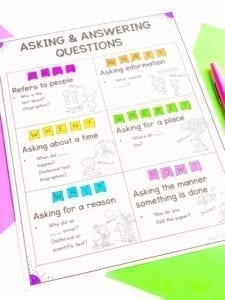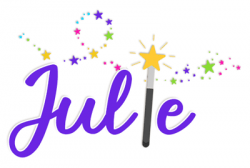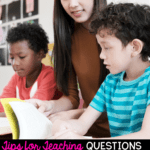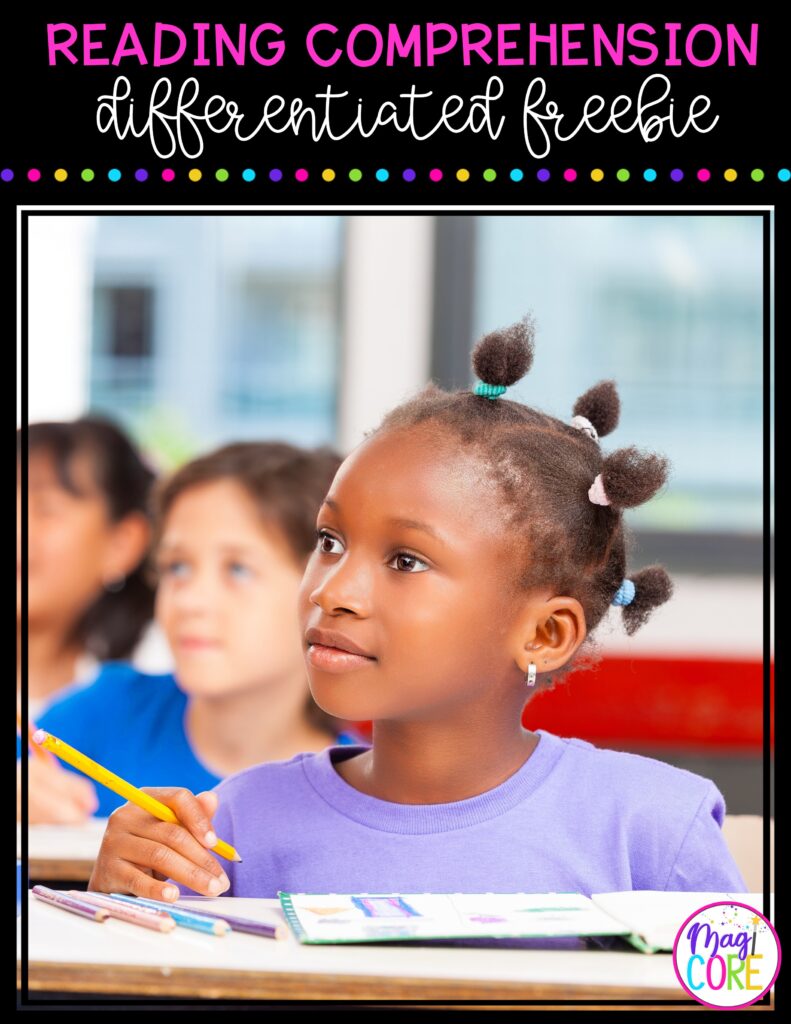Asking and answering questions in nonfiction is a core skill for 2nd grade and 3rd grade reading comprehension. Because these skills help students learn how to understand what they are reading, teaching these skills comprehensively is an important foundation for creating strong readers. I am sharing this teaching method because it was very successful in my own classroom. In this post, I walk through my strategies for teaching ask and answer questions skills.
NOTE that this post contains affiliate links*.
The 2nd and 3rd grade ask and answer questions in nonfiction text standards, RI.2.1 and RI.3.1, are closely aligned. Both standards require students to determine what the text says explicitly to understand the key details within the text. The only major difference between these two standards is that the 6 Ws are used as the types of questions in the 2nd-grade standard, whereas the 3rd-grade standard does not expressly refer to the 6 Ws. Ultimately, students in both grades should be able to ask and answer explicit questions.
This chart will help you unpack this standard:
Since this is one of the most basic standards, I always teach Ask and Answer Questions at the very beginning of the year at a basic level. I then revisit this skill periodically throughout the year to reinforce student monitoring of their own comprehension.
Begin teaching this unit by selecting mentor texts that can be used to model this strategy. I recommend the following picture books, but you can use any of your favorites.
It is important to have a balance of resources that include both real texts and passages. Doing so will help students understand that the standards they are learning should be applied to all reading materials, which will add practicality to the lessons.
Discuss the key vocabulary you will focus on during this ask and answer questions in literature unit.

Explain that good readers ask and answer questions before, during, and after reading. They ask a variety of questions to ensure that they comprehend what they are reading. Review the question words of who, what, when, where, why, and how, and discuss what each word means. Be sure to tell students that not all of these questions will always be asked and answered in one book. For example, if you are reading a book about a science topic, there isn’t always a person, so you would not ask a “who” question.
Tell students that you are going to model how good readers ask and answer questions while reading this book.
If you would like the full lesson plans and sticky note questions for The Story of Ruby Bridges by Robert Coles, you can grab my Mentor Standards unit on Asking and Answering Questions here. While reading, be sure to model going back into the text and rereading to find the answer to questions that are “right there.”
Model asking and answering questions on the sticky notes. Chart your questions and responses on the “Ask and Answer Questions” anchor chart.
On day two, focus on a new story. I use What Is the World Made Of? by Kathleen Weidner Zoehfeld.
Read the book, stopping at points to pose the questions on the sticky notes. After posing each question, allow students time to turn and talk to discuss the answer. Students can record their questions and answers on the sticky note template and journal pages. For each question, select one person to share his or her response. Reread portions of the text when needed to model going back into the text. Have students select one question for each question stem to record on their flipbook activities.
For the third day, I suggest selecting a book that lends itself to students working in partners or small groups. I like using Curious Critters by David Fitz Simmons because each page focuses on a different animal and students do not need to read the entire book.
Begin by showing students the cover of the book. Tell students that they will practice asking and answering questions with partners today. Select a few animals (2-3). Read each animal page aloud, stopping at the end to allow students to ask, answer, and record questions with their partner. Have students record their questions and answers on sticky notes and the sticky note template. If you have a projector, project the text and photograph so that students can refer to the text.
Once students have had ample time to watch you model and practice in partners, have students practice asking and answering questions in nonfiction independently using their independent reading journals.
*Note: I recommend that independent reading is the largest block of time during reading workshop or centers. Students need this time to engage in literacy and work with text of their choice at their level. You can read more about why independent reading is so important.
Each day after reader’s workshop is over, have everyone gather in your meeting spot with their journals and bag of books. Select about two students to share their independent reading practice. For this skill, students should share the book they read and one of the questions they asked and answered. They can also share any problems they came across. For example, if they were unable to answer their question, how they reread to find the answer.
Towards the end of the week, when students have had ample time to practice asking and answering questions, students rate how their independent reading work shows their mastery of the standard on a mini rubric in their journal. On the final day of the lesson, conduct very short conferences with each student to review their work and rubric and discuss next steps.
When I teach asking and answering questions at the beginning of the year, I leave the lessons to picture books and student chosen literature. I typically introduce asking and answering questions with passages when I revisit this standard the next time. If you are teaching this lesson at a later point in the year, you can introduce passages and literature simultaneously.
If possible, I recommend you do passage and question practice immediately after week 1. It is important for students to see how the ask and answer questions in nonfiction skills they learned the previous week transfer to passage reading; however, it is unrealistic to expect students to automatically translate the skills they learned without explicit instruction and guided practice.
1. Open the lesson by showing students an anchor chart discussing the difference between “Right There” explicit questions and inferential questions. Tell students that today, you will model how to answer explicit and inferential questions.
2. Show students a one-page passage either blown up on chart paper, or on a projector. For more details on how I make my passages into posters, check out my blog on How I Teach Common Core Reading.
3. Model how to close read the sample passage. Read it through one time, stopping to think aloud about the topic. Then model answering a few questions. Be sure to think aloud about how to determine if the question is an explicit or inferential question.
4. Model how to underline the text evidence directly in the passage. I like to model using different colored crayons, colored pencils, or markers and have students do the same. This strategy is integrated into my 2nd & 3rd Grade Common Core Reading Passages.
1. Have students help you answer the remainder of the questions. For some questions use turn-and-talk or have students come up to underline text evidence on the poster.
If your students need more support before working independently, you can have partners work on passage and question sets together on the following day. During this time, I would also pull a small group with my students who are reading well below level and work with them on a text they can have success with. For many of my ESE, ESOL, or intervention students I would use my first-grade passages.
1. Students work on asking and answering questions in passages independently. I recommend scaffolding the passage levels you use.
2. For more scaffolding and differentiation tips, see my Teaching Reading Passages blog post.
3. Students continue to practice reading passages for RI.2.1 until most of the class is showing mastery.
1. On the final day (typically at the end of the week), I administer an assessment for answering questions RI.2.1 & RI.3.1. You can find Lexile leveled assessments to use in my Ask & Answer Questions in Nonfiction resource.
2. The day after administering the assessment, I go over it with students. For more tips on reviewing and correcting assessments, visit my Teaching Reading Passages blog post.
After you have thoroughly taught asking and answering questions in nonfiction, it is important to continue to model and expect students to apply their skills to all reading, including read-alouds, independent reading and guided reading. It is important skills aren’t taught in isolation. We want students to apply these skills and strategies throughout their daily lives to become stronger readers and thinkers. When reading, asking and answering questions is only one part of the puzzle.
You can view all my Ask & Answer Question resources here.
These are the two products I featured in this blog post:
*Magicore is a participant in the Amazon Services LLC Associates Program, an affiliate advertising program designed to provide a means for us to earn fees by linking to Amazon.com and affiliated sites.

We strive to create resources that empower teachers and transform student success. We create skill-focused resources that promote critical thinking, enhance student engagement, and incorporate diversity. Our goal is to develop the tools teachers need to reach their students and foster a lifetime of learning.


2 Responses
I would love access to your asking and answering questions unit. Thanks!
Rachel,
Thank you for the question. You can access all of my Questions/Inferences in Nonfiction resources here: https://commoncorekingdom.com/ask-answer-and-making-inferences-in-nonfiction
Thank you!